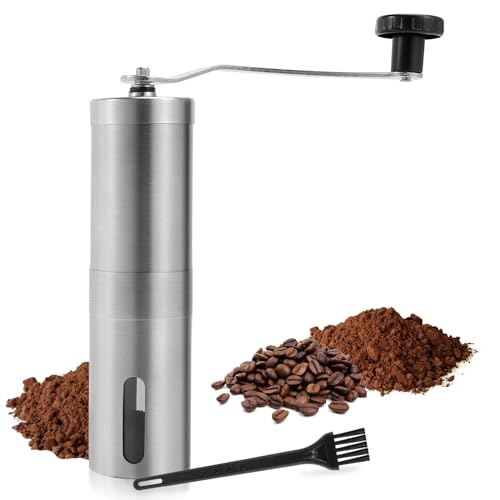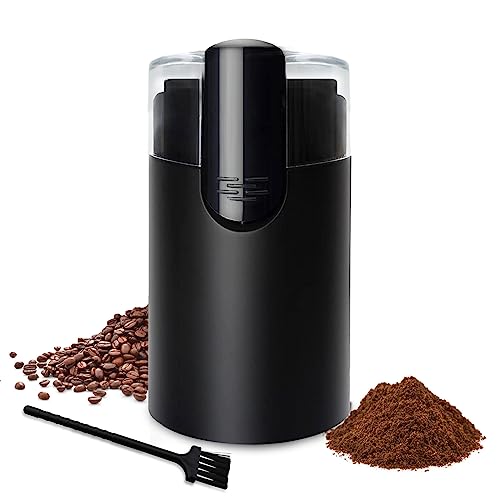12 Stats About Ceramic Grinder To Make You Think Twice About The Water…
페이지 정보

본문
 The Advantages of a Ceramic Coffee Grinder
The Advantages of a Ceramic Coffee GrinderCeramic grinders are renowned for their long-lasting durability and enduring. They last longer than steel blades and won't be damaged by corrosion or rust when exposed to warm temperatures. However, they are not as sharp as stainless steel.
A dual-tool grinding machine consists of a ceramic wheel for rough grinding and a movable wheel for finishing grinding. This innovative solution permits the machining of shaped surfaces with variable curvature using one machine tool.
Blades with high-strength
The blades are constructed of an extremely durable material that keeps its sharpness for longer than steel. This feature ensures the quality of coffee beans, which is a crucial factor to consider when choosing a grinder. This feature helps to ensure a consistent grind, which is vital for a successful brewing process. This is especially important when brewing espresso, as the inconsistent grind can result in poor extraction.
Ceramic grinders are easy to clean due to their durability. This is because the ceramic burrs aren't susceptible to rust-related contamination and other metal particles. The non-metal blades don't leave marks, which may require extra cleaning, on surfaces like tiles or stone. Ceramic blades are also less prone to rust and won't alter the coffee's flavor.
Ceramic blades are relatively new. They were initially developed for industrial processes requiring round rotating blades, and later introduced into kitchens at home. These blades are more durable, however their price and time-to-use must be considered. However, the long-term advantages of a ceramic blade may be worth the extra cost.
All ceramics start as a powder or clay which is then mixed with water to form an adhesive. The final shape of the ceramics is then pressed. The "green" ceramics that result are very soft and difficult to machine, so they need to be "sinterned" or fired to harden. Afterward they can be machined with relative ease.
 Ceramics are employed in many manufacturing applications, ranging from semiconductors to surgical instruments. Zirconia is an extremely solid and hard material. Zirconia can be made into components using different methods, including laser cutting, scribing and breaking, as well as mechanical sawing. The components can be polished and inspected to see the microstructure inside. This way, the exact properties of the ceramic will be identified.
Ceramics are employed in many manufacturing applications, ranging from semiconductors to surgical instruments. Zirconia is an extremely solid and hard material. Zirconia can be made into components using different methods, including laser cutting, scribing and breaking, as well as mechanical sawing. The components can be polished and inspected to see the microstructure inside. This way, the exact properties of the ceramic will be identified.Non-stick coating
The nonstick ceramic surface of a grinder prevents resin accumulation. This coating is easy to clean and does not corrosion, unlike other metals. It is also odorless, long-lasting and resistant to chemical and scratches. Nonstick coatings do not all possess the same properties. It is important to understand the differences between different kinds of coatings, and how many layers are there and whether they are reinforced or not.
Nonstick coatings date back to the time of Greek cookware. Archeologists have discovered a number of pots that had coatings that stopped the dough from sticking to the pan. However, the modern nonstick coating was accidentally discovered in 1938 when a Chemours employee named Roy Plunkett accidentally created polytetrafluoroethylene (PTFE). This high-density, heat-resistant synthetic chemical compound has a unique property: it resists the formation of oil droplets on its surface. It was trademarked as Teflon and began appearing in cookware as early as the 1960s.
Nonstick grinding materials are utilized in a variety of industrial manufacturing processes. These include form grinding, which is a specific cylindrical grinding process that makes parts in the exact shape of the product that you want. These components are made from a variety of materials, such as Yttria-stabilized zirconia or Alumina. These materials are cost-effective and wear resistant. They are extremely durable and are chemically stable.
In addition to protecting against contamination, ceramic grinding tools assist in controlling the heat generated during the milling process. It is essential to have a proper cooling system to maintain the integrity of your workpiece and extend the life of your tool. This is because excessive heat can cause the pores of the grinding wheel to break which can lead to the loss of precision in dimensional measurements.
SLX has created a V2.5 ceramic nonstick surface for their grinders. It performs just like your first Teflon frypan. In contrast to Teflon the coating is free of PFOA or PTFE and is completely inert. FDA certified safe for contact with food and comes with a lifetime warranty. The SLX grinders also come with an engraving of PTFE patent and lot number to verify.
Easy to clean
Ceramic grinders have an advantage over steel ones in terms of maintenance since they are less prone to heat buildup and do not retain as many oils. However, even these types of grinders need regular cleaning to ensure they are in good working order. You should clean your grinder at least once per week to avoid creating a sticky mess. This will keep it clear of dirt and will not alter the flavor or aroma of your marijuana.
Take off the lid, hopper and any removable gaskets. The components should be cleaned by using hot soapy water and then rinsed thoroughly. After washing it, you can use a brush to scrub the burrs as well as the internal areas of your grinder. Rinse and dry the grinder thoroughly to avoid the formation of rust.
Ideally, you should use a firm paintbrush or toothbrush to remove stubborn gunk from the hard-to-reach areas of your grinder. Utilize the attachment of a vacuum cleaner or hose to get rid of any remaining residue. Be careful not to get any screws or parts of your best coffeee grinder. Once you're done, your grinder should appear like new.
If you don't have a vacuum or brush you can boil your metal grinder to clean it. To do this, fill a pot with warm milk and then heat it to about 150 degrees Fahrenheit (66 Celsius). Submerge the metal grinder into the liquid when the temperature is just right. After about an hour, take out the grinder and scrub it with a brush. Then, rinse it off with hot water that is clean and let it dry completely prior to using it again.
If you don't want to use chemicals, you can use a hairdryer, or the inside of an air conditioner to dry your grinder. Clean the hopper and bin with a lint free cloth. Avoid using the blower's nozzle near any moving parts, since it can melt plastic or paint. You can also make use of a commercial cleaning product like those used by coffee shops to break down the oily residue.
Durable
In contrast to stainless steel grinders ceramic grinders are not prone to corrosion and will not be rusty. Ceramic is also renowned for its hardness, which makes it perfect for grinding tasks that require precision. Ceramic grinders are favored by professional baristas as well as home chefs. They are also less expensive than stainless steel grinders. This makes them an ideal choice for shoppers with a tight best budget espresso grinder.
The durability of a ceramic grinder is heavily dependent on its type of construction. The sharpness and durability are affected by the material used to manufacture them. This is why it's important to choose a ceramic grinder with top-quality stones that are securely seated inside the grinder. It's also important to keep the grinding wheels clean and free of dust by making use of a lubrication system as well as the right cutting fluid. The ceramics in a ceramic grinder can be damaged due to excessive heat, which is why it's crucial to select a slower speed setting to reduce the amount of friction generated.
Ceramic burrs also have a lower thermal conductivity than stainless steel ones. This feature can help maintain the desired flavor quality of the grinding process by reducing the risk that the coffee maker with grinder compounds could be damaged by overheating. In addition they are more resistant to wear and tear and allow them to keep their sharp edge for longer.
Ceramic grinders also produce less fines and also retain less oil, leading to cleaner grinding and less residue left on the grinder. They are easier to clean and maintain, and maintenance costs can be reduced significantly compared to steel-based grinders.
Another benefit of a ceramic grinder is that it is able to withstand higher temperatures than stainless steel, making it a great option for environments that are subject to the widest range of ambient temperatures. This is particularly useful for espresso coffee grinder drinks that are made at higher temperatures than other varieties.
While there are some advantages to both types of grinders, it's important to weigh the advantages and disadvantages of each. The stainless steel grinders are generally more affordable and have a premium feel. However, they can become duller or more damaged over time, leading to more expensive maintenance costs. Ceramic burr grinders are long-lasting and provide a consistent size of grind, however they may be more costly initially.
- 이전글The Reasons Double Glazing Windows Maidstone Is Everywhere This Year 24.08.28
- 다음글American Fridge Freezer With Water Dispenser: The History Of American Fridge Freezer With Water Dispenser In 10 Milestones 24.08.28
댓글목록
등록된 댓글이 없습니다.